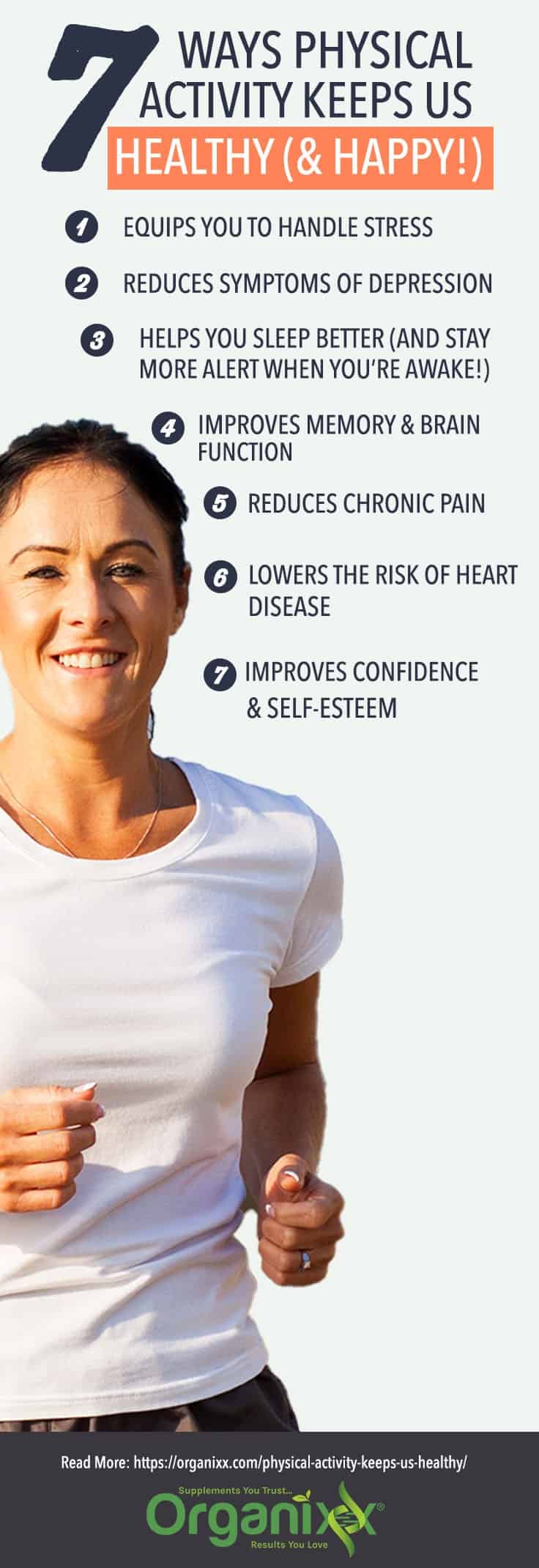Engaging in regular physical activity is one of the best things you can do to support your health! Most of us understand how exercise benefits our bodies physiologically, but did you know that physical activity is beneficial to your mental and emotional well-being as well?
Need some motivation to start moving your body? Here are 7 ways that staying physically active can help you lead a happier, healthier life.
#1 – Equips You to Handle Stress
If you use exercise to help manage your stress, what you’re doing is actually backed by science. Physical activity creates small doses of managed stress in our bodies, which is actually really healthy for us. In response, our bodies produce chemicals like endorphins, serotonin, and norepinephrine. These chemicals play an integral part in the body’s ability to respond to stress [1].
The more that we exercise, the better we can streamline communication between the systems involved in the body’s response to stress. When other stressors occur, our bodies can be better equipped to handle the response, resulting in a more calm and optimistic approach to stress.
#2 – Reduces Symptoms of Depression
Depression is the leading cause of disability in the United States [2]. According to the Mayo Clinic, just 30 minutes of exercise each day can significantly improve symptoms of depression, and even smaller amounts of physical activity can make a difference [3].
Exercise can help by releasing endorphins (hormones that activate the body’s opiate receptors and cause an analgesic, or pain-relieving, effect) and offering greater opportunity for social interaction. In fact, a French study in 2014 found that associations between physical activity and social functioning appeared to determine happiness levels in older adults [4].
Exercising outside can offer even more benefits, as increasing vitamin D levels has been shown to reduce both anxiety and depression.
#3 – Helps You Sleep Better (and Stay More Alert When You’re Awake!)
 You may not have considered that physical activity has a direct effect on sleep, but a study published in Mental Health and Physical Activity says exactly that [5].
You may not have considered that physical activity has a direct effect on sleep, but a study published in Mental Health and Physical Activity says exactly that [5].
According to the study, sleep is significantly improved in those who get at least 150 minutes of exercise each week. The study also found that regular physical activity can help fight fatigue, leaving us less sleepy and more energized during the day.
Sleep is important, and getting better sleep through physical activity can reduce inflammation, boost the immune system, and help the body detox.
#4 – Improves Memory & Brain Function
Physical activity helps improve memory and brain function in several ways. First, both poor sleep and chronic stress can contribute to cognitive impairment. Because physical activity has a positive effect on sleep and stress, it can indirectly improve cognitive memory.
Next, exercise can help memory because of its physiological benefits, such as reducing inflammation and stimulating the release of growth factors [6]. This positively impacts brain health, and increases the quantity and longevity of brain cells.
Finally, aerobic exercise has been shown to improve function of the hippocampus, the part of your brain involved with learning and memory [7].
#5 – Reduces Chronic Pain
There are a number of studies indicating that exercise may provide relief from chronic pain [8]. Although rest and inactivity have long been recommended for those with chronic pain, new research shows that physical activity is an important part of treatment.
Interestingly, chronic pain also contributes to stress, depression, and poor sleep. Staying active can help address these issues in many ways. Patients often fear that physical exercise may increase pain further, but the studies showed that muscle soreness that sometimes occurs with starting a new exercise subsided as the participants adapted to new activities [8].
#6 – Lowers the Risk of Heart Disease
Heart disease is a leading cause of death in the United States. According to the American Heart Association, more than 60% of Americans are obese or overweight. Physical activity helps prevent high blood pressure, obesity, and poor cholesterol levels, all of which contribute to heart disease [9].
Exercising also helps boost lung function and circulation, keeping your body conditioned and ready to perform.
#7 – Improved Confidence & Self-Esteem
Physical activity also leads to better self-esteem and body image [10]. The health benefits listed above leave us feeling less stressed, well-rested, physically fit, and mentally resourceful. This results in more confidence and self-worth.
In fact, a 2010 study at the University of Michigan found that middle school children who were most active scored highest in displays of both leadership and empathy [11].
Physical exercise is an important part of your body’s health, and can have a synergistic effect on sleep, stress, depression, inflammation, pain, and more.
The benefits we gain from exercise have a significantly greater impact than the immediate results that we can observe. From emotional health, to brain function, to heart disease, your whole body (and mind!) will benefit. There are varying types and amounts of physical activity recommended for different goals, so be sure to consult with your healthcare provider to find out what type of program is right for you.
Magnesium deficiency is linked to stress, diabetes, heart disease, osteoporosis, chronic fatigue syndrome, depression, anxiety, trouble sleeping, sore muscles, migraines, and many more debilitating health conditions.
If your body needs magnesium, you want the most beneficial kind your body can actually absorb. Organixx Magnesium 7 gives you seven (7) of the very best, most bioavailable types of elemental magnesium available.
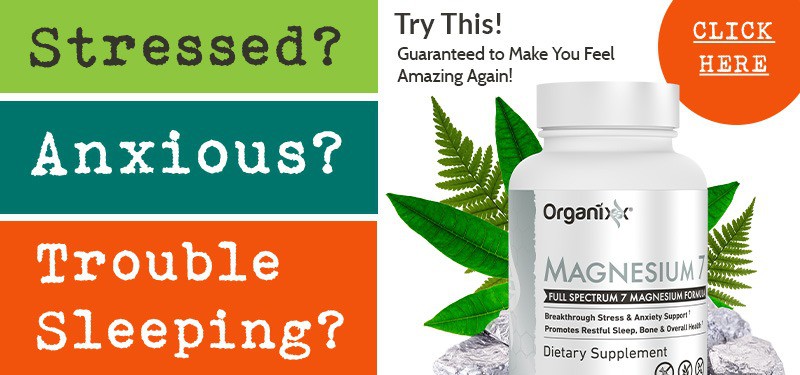
Routines. Some people live by them, some people rebel against them. The fact is that most successful, health-conscious folks stick to at least one. This is the one they do in the morning to set themselves up for a frictionless, stress-free day. For a large majority of people, part of this routine includes morning stretches.
Can you spare less than 10 minutes in the morning to get limbered up, revved up, and ready for your day? If so, read on!
The Importance of Routine
If we can convince you to commit to any kind of routine, it would be the one you do in the morning. A morning routine clears your mind. With a routine in place, you can put your energy into the important things by spending less time focusing on less important decisions each day.
For instance, former President Barack Obama’s morning routine used to include a daily choice of either a blue or gray suit.
“You’ll see I wear only gray or blue suits,” said Obama in an interview for Vanity Fair magazine in 2012. “I’m trying to pare down decisions. I don’t want to make decisions about what I’m eating or wearing, because I have too many other decisions to make [1].”
By making morning stretches part of your daily routine, you don’t need to think about it each day… and you’ll start your day off on a high note.
What Happens to Your Body and Mind by Morning
If you’re like most people, you probably wake up most mornings a little groggy with at least some amount of muscle stiffness. In addition, there may be a million annoying thoughts racing through your head… and possibly even some back pain to boot!
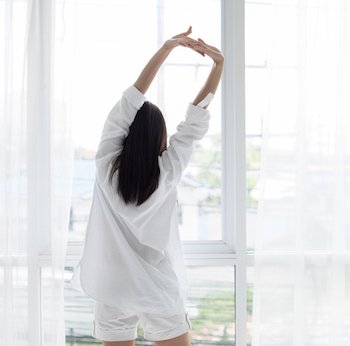
According to a recent survey, most Americans wake up thinking about either their finances or the tasks they must do during the day [2].
Most adults also wake up with achy joints and sore muscles.
This has more to do with physiology than psychology. When we put our bodies to rest, not only do we lie horizontally with very little movement for hours, but our body’s core temperature lowers, just as the planet does at night. Our body temps gradually decrease as the night goes on, reaching a max low point just before dawn, when the alarm clock goes off [3].
According to a 2016 study conducted by the University of Manchester in England [4], the body’s biological clock also suppresses anti-inflammatory proteins during sleep. This means that the natural pain relievers in our bodies during the day are not as prevalent when we sleep.
They are absent in the early morning as well. With our cold bodies, racing minds, sluggish blood flow, and stiff joints, no wonder most of us reach for coffee first thing in the morning.
There is another solution to the early morning blues. Starting the day by gently stretching for 5 to 10 minutes and taking a little time to calm the mind with meditation can help reduce scrambled thoughts and aching bodies.
The 9-Minute Morning Stretch
A simple search on Google will populate dozens of morning stretch routines that target different muscle groups. Have fun exploring all of them or create one that suits your individual needs.
In the meantime, we’ve compiled some of the best morning stretches to create a simple routine which will have you flexible in both mind and body, ready to start the day in no time.
#1. Mountain Pose / Time: 1 minute
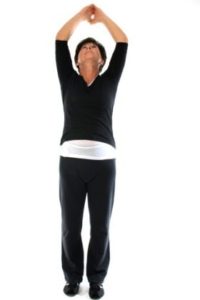 On a mat or carpet, stand with your feet flat and hip distance apart. Put your palms together in front of your chest. Take a moment to tune in to your body. Stand tall and imagine your joints completely aligned.
On a mat or carpet, stand with your feet flat and hip distance apart. Put your palms together in front of your chest. Take a moment to tune in to your body. Stand tall and imagine your joints completely aligned.
Breathe and feel the expansion and contraction of your chest and rib cage. As you exhale, release the tension in your neck and shoulders. Take 3-5 more conscious breaths.
On your next inhale, raise your hands above your head, keeping your palms together. As you exhale, try to reach the ceiling with your hands while imagining your ribcage and shoulder blades reaching for the floor.
Gaze straight ahead and take one more inhale and exhale. Slowly bring your hands down to chest level again, keeping your palms together.
#2. Raised Arms Side Bends / Time: 1 minute
Starting in Mountain Pose, raise your arms over your head again as you inhale. Next, take your right wrist in your left hand. As you exhale, bend to the left until you feel a stretch on the right side of your body.
Be sure to keep your chest open (no slouching) and your gaze forward. Stay in this position, stretching to the left side, for two more complete breath cycles. Each time you exhale, try to stretch a little more.
Slowly come up to center. Then switch sides by holding the wrist of your left arm and stretch to the right. As you stretch on both sides, pay attention to your core. Stay centered with both feet on the floor for balance. Bend your knees slightly if needed. After you have stretched on both sides, come back to Mountain Pose.
#3. Rag Doll / Time: 1 minute 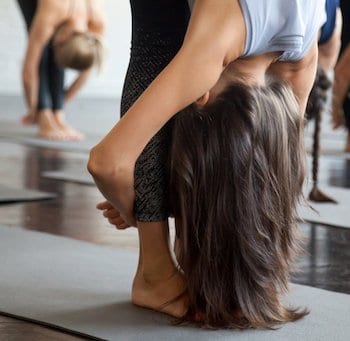
From standing, exhale as you bend slowly forward, reaching for the ground. Be sure to bend from your pelvis area, instead of your lower back, and bend your knees to bring your knees to chest as much as you need to for balance and comfort.
Hang and breath softly, allowing your upper body to simply droop while feeling a gentle hamstring stretch (the muscles on the backs of your thighs).
You can brush your fingers on the floor, clasp your hands around your elbows, or lightly place your hands on your ankles or knees. Remain inverted for 2 or 3 breaths.
Come up very slowly, imagining each vertebra becoming upright one at a time. Once upright, take one or two slow, deep breaths to center before moving on to the last stretch.
#4. Heaven and Earth Stretch / Time: 1 minute
This stretch is inspired by energy medicine master Donna Eden [5]. She herself says that Heaven and Earth may be one of the oldest stretches ever, used in tai chi and other ancient healing and martial art modalities for centuries.

Stand upright with your arms at your sides and your feet flat on the floor and slightly apart. Rub your hands together and shake them out. As you inhale, stretch one hand to the ground while the other arm reaches to the ceiling.
Flatten your palms (one should be facing “Heaven” and the other to “Earth”). As you exhale, look down at the hand that is reaching for the ground. Slowly bring both arms to center (straight out from your shoulders). Then reverse for another 2-3 breaths. This move is a great one to do outside, especially barefoot for grounding, and facing the sun as it is just coming up.
It is hard to not smile while doing this move and it can give you energy all morning long. It’s also a great one to do whenever your energy dips throughout the day or you have encountered something stressful.
#5. “Gratitude for the Day” Reflection / Time: 5 minutes
After completing the stretches, sit on your bed (on the side or cross-legged) or a chair. Expand and contract your spine from your hips slowly 3-4 times, inhaling as you expand and move forward, and exhaling as you contract.
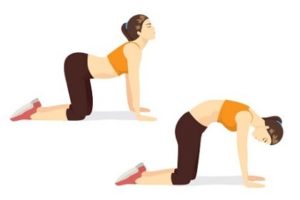
If you are familiar with the “cat/cow” stretch, this is similar, only it is done while sitting (see graphic for cat/cow movement).
Go back and forth as many times as you want, until you feel an easy stretch in your lower back. But don’t strain; take your time and go slow.
Next, close your eyes and monitor your breath. There are dozens of ways to reflect, and many involve specific breathing techniques. For this one, just observe your breath, as well as thoughts that may come in and out of your mind. The purpose of the first two minutes of this reflection is to eliminate judgement. Simply observe whatever is happening both inside and outside of you.
Finally, for the last three minutes, zero in on one thing you are grateful for as you start your day. Focus on that and imagine the gratitude for this one thing filling your heart with warm light. As you breathe in and out, imagine this light encompassing your whole being.
Dozens of studies have connected feelings of gratitude with improvements in health. For example, a 2015 study of heart disease patients, conducted at the University of California, San Diego in conjunction with the Chopra Foundation in La Costa, California, found that individuals who displayed tendencies towards gratitude and appreciation had less fatigue, were less prone to depression, slept better, and had less systemic inflammation overall [6].
Whether you are already keen on routines or would rather do without them, why not give this simple morning stretch and gratitude routine a try and see what happens. You may find that the rest of your day, and even your entire week, is better off for it!
If you’re not getting all the nutrients and antioxidants you need from food, your best source is whole food vitamins. Organixx Multi-Vita-Maxx contains 21 uniquely fermented vitamins and enzyme-activated minerals that are more “bioavailable” and easily absorbed by your body than the synthetic compounds found in most supplements.

Everyone knows that exercise is a good thing. Establishing a workout program for just 30 minutes a day, coupled with strength training two days a week [1], can provide you with many health-boosting benefits.
These workout benefits include improvement in multiple areas, including:
- Weight loss
- Diabetes
- Anxiety & Depression
- Inflammation
- Heart health
- Osteoporosis
- Cancer
- Gut health
- Sleep, Focus, and Libido
If you’ve never had the healthy habit of a workout program or you’ve recently fallen off your diet plan (or treadmill), you may not know how to get started (again). How do you stick with a workout program that is going to give you the results you want?
Read on for six tips designed to motivate you to get moving and KEEP YOU MOVING every day!
6 Tips for Creating a Healthy Workout Program That Works for You
#1. Love Yourself as You Are
You may be unhappy with your body or struggle with a physical condition that makes exercise more challenging. Whatever your situation, it’s important to establish self-worth before beginning your exercise journey.
Take out a journal or a piece of paper and write down three things that you appreciate about yourself and your body. Then copy them down on a post-it and tape them to your bathroom mirror. Put them where your workout clothes are. Stick a reminder of them by your front door. Make sure you see them throughout the day.
Why do all this before you start exercising? Because beating yourself up about the size of your calves, high blood pressure, jeans that are too tight, or a diabetes diagnosis is going to motivate you for about 5 minutes.
Starting this new and exciting chapter of your life with a clear awareness of the amazing qualities you already possess will build your confidence and make you feel good. This, in turn, will help you be more of your full-throttle, amazing, and totally awesome self as you gain energy and endurance by moving your body every day.
“It’s important that people love themselves now for who they are and not for what they want to become,” advises personal trainer Jonny Straws when asked how to stick to a workout program for the long-term [2].
#2. Visualize Success
Over two millennia ago, the philosopher Aristotle stated: “First, have a definite, clear, practical ideal; a goal, an objective. Second, have the necessary means to achieve your ends; wisdom, money, materials, and methods. Third, adjust all your means to that end [3].”
It seems that goal-setting is just something we humans do naturally, not only in fitness, but many important aspects of our lives. It is easier to start down the path if we know where we are going.
Many of us are great at making plans but can lose steam along the way. Sometimes, as the days and weeks go by, our goals may seem farther away than ever. Other times, we forget about what they were in the first place.
Consistent, intentional visualization is the missing piece when it comes to setting goals. Engaging in a visualization practice every day, even for a few minutes, helps to keep our goals fresh. It also helps us achieve our goals by adding images and emotions to what we want to accomplish.
The effectiveness of visualization is backed up by neuroscience. Every time you have a thought, you are creating specific neuropathways in the brain. Here is how it works:
When you think about something happy, you create neuropathways for happiness. When you think stressful thoughts, you create neuropathways for stress. Over 75 years ago, Canadian psychologist Dr. Donald Hebb coined the phrase, “Neurons that fire together, wire together [4].” This occurs in our brains every day based on what we are thinking.
Visualization techniques use the way the brain inherently works to help create the reality we want in the physical world. Spend just five minutes every day imagining yourself running up those flights of stairs, swimming those laps, or dancing your socks off to your favorite tune.
Then imagine yourself enjoying your strong, lean, powerful, and healthy body with as much feeling and mental imagery as you can muster. By doing this, you are creating more neuropathways for this experience and are helping turn your fitness dreams into reality!
#3. Take it Slow
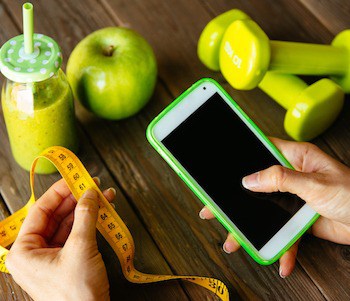 If you’re just starting a workout program, remember that you don’t have to run a marathon your first week. In fact, it will probably hurt you in the long run if you push yourself too hard in the beginning.
If you’re just starting a workout program, remember that you don’t have to run a marathon your first week. In fact, it will probably hurt you in the long run if you push yourself too hard in the beginning.
Remember that adding movement to your daily routine is a lifestyle change and you are in it for the long haul. So take it slow and gradually build up your endurance as you go along.
For example, start out with a 15-minute walk 3 times your first week and gradually increase to 20 minutes 4 times in week 2. Or dance to 1 song a day during the first week, then groove to 2 songs a day the next week.
You may also consider exploring exercise classes for the first few months of your commitment to fitness. Try one exercise class at your local gym or rec center each week until you find one you really enjoy. Then commit to going twice a week instead of just once.
Not all exercise needs to be super intense for there to be health benefits either. Did you know that stretches that gently twist the spine can have positive effects on the adrenals, thyroid, and pancreasand activate the healing hormones of the parasympathetic nervous system [5]?
#4. Make it Fun
The number one excuse people have for not exercising is because they “don’t have the time.” A recent article in Psychology Today [6] posits that there is another reason why we don’t get off the couch and put on our gym clothes: exercise is uncomfortable.
Dr. Sherry Pagoto, a licensed clinical psychologist and professor at the University of Massachusetts Medical School, explains that exercise is uncomfortable to most of us because it goes against the relative comfort which defines how most people live in the modern, industrialized world. According to Dr. Pagoto:
“We live in a society where we keep the indoor temperature adjusted to perfection all year round, wrap ourselves in soft clothing, wear thick-soled shoes to protect our feet from harm, lay on cushy beds draped in poofy covers, and shower and scrub with warm water and soap every single day. Is all of this First-World pampering making us intolerant to even mild physical discomfort?”
How many people really revel in the idea of getting blisters, sweating profusely, being out of breath, messing up their hair, and having sore muscles? Pagoto suggests getting out of our physical comfort zone as much as possible to prepare for regular exercising. Going out in the rain without an umbrella, letting yourself get dirty in nature, or stomping in a puddle so your shoes and socks get wet are good examples.
For those of us who are not as courageous, however, there is another (kinder) way to ease into a workout program that works for you and stick to it. That is to have fun!
Do you remember the last time you went to a concert and danced yourself into a sweat, but didn’t even realize it? Engaging in a physical activity that you really enjoy will increase the likelihood that you will “stick to it.”
Here are some activities that might point you in a fun direction. And, yes, they are all considered a “workout:”
- Brisk walking
- Taking a dance class
- Swimming
- Rocking out to your favorite tune
- Running with your dog
- Hiking or biking at the park or the beach
- Martial arts
- Paintball
- Indoor rock climbing
- Bouncing on a trampoline
- Watching your favorite show while you’re walking briskly on the treadmill
- Going on a “walking meeting” instead of talking in the office or a coffee shop
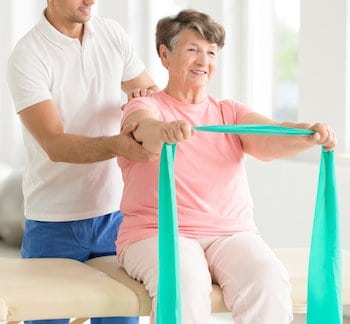 The concept of strength in numbers also applies to working out. As social beings, having a workout partner or joining a class not only is more fun, it also helps us feel like we are not alone.
The concept of strength in numbers also applies to working out. As social beings, having a workout partner or joining a class not only is more fun, it also helps us feel like we are not alone.
A study published in the Journal of Social Sciences found that people are influenced by the exercise behaviors, healthy or otherwise, of others around them [7]. So if your friends and family don’t exercise, try and find a group of people who can be a positive role model for you.
#5. Work Exercise into Your Schedule
When it comes to finding the time in our busy schedules for working out, experts advise creativity and planning [8]. Remember that you don’t have to do it all at once.
Here are a few ways you can get your heart beating when you are on the run:
- Take the stairs
- Park a few blocks away
- Bike to work
- Consider a workout app for your phone or computer. Many have programs that will get you sweating in 15 minutes
- Try burst training or HIIT [9]
- Use your lunch hour to take a brisk walk or a jog
- Do squats, stretches, or other movements whenever you are on hold on the phone, waiting for dinner to cook, or even sitting in the office or in traffic
#6. Celebrate Success
Finally, keep in mind that working out doesn’t have to be all work. Experts in the field of operant conditioning (learning through positive and/or negative reinforcement) state that when individuals engage in activities that elicit positive responses or rewards, they will be more likely to repeat them.
So be sure to take the time to celebrate your successes in a healthy way whenever you reach weight loss, time frame, or other fitness goals. Book a massage, enjoy a spa day, or treat yourself to a new outfit to celebrate all the new energy, strength, and fitness you are going to experience as you get into the groove of your daily workout program.
Organixx Clean Sourced Collagens blend contains five types of collagen from four sources. What’s more, it’s combined with targeted nutrients such as zinc, vitamin C, and vitamin B6 which specifically enhance the bioavailability and potency of collagen. Clean Sourced Collagens is formulated from the ground up to enhance and support your body’s natural ability to heal and rebuild itself from the INSIDE out.

Rebounding is a type of exercise that utilizes a small trampoline (called a “mini trampoline” or “rebounder”) for low-impact exercise. Individuals can perform a wide range of movements on a rebounder, including bouncing, twists, running in place, jumping jacks, side-to-sides, and even dance moves.
Trampolining is popular in fitness circles today, and promoters list a plethora of physical benefits from regular use. But are those claims supported with actual results?
Most natural health experts and thousands of “trampers” say YES!
Rebounding is a fun way to get your daily dose of aerobic exercise, which is extremely important to maintaining long-term health. But it seems to especially benefit the lymphatic system, reducing inflammation.
The Importance of Movement for Lowering Inflammation
The lymphatic system consists of the tonsils, bone marrow, spleen, lymph nodes, and, of course, lymph (the fluid that circulates throughout the lymphatic system).
This system has a dual function:
First, it is one of the main ways that the body eliminates toxins. It does this by circulating lymph, which carries waste and other byproducts through the nodes and out of the major detoxification pathways, especially the liver.
Second, the lymphatic system helps your body fight pathogens via the immune system, since lymph carries immune system cells. Pathogens are stored in the lymph nodes until B and T white blood cells, or lymphocytes, destroy them.
Your lymphatic system sounds like a well-oiled machine, right? Well, it is except for one caveat: unlike your blood, which has the heart and other cardiovascular mechanisms to push it through your body, the lymphatic system has no pump at all!
This is where exercise, such as rebounding, comes in. Did you know that you have three times more lymph than blood running through your body at this very moment? And the only way this fluid can keep moving is if you do.
That’s right – muscular contractions take place as you exercise, and this is the only way that lymph can circulate.
You may have heard of conditions such as lymphedema, edema, and fibrosis. According to the Lymphatic Education and Research Network (LERN) [1], there are roughly 10 million Americans who suffer from lymphedema and other lymphatic diseases.
These painful and sometimes debilitating conditions are all different manifestations of the same thing: lymph that is not flowing properly through the body. Stagnant lymph inevitably leads to inflammation, which is the foundation of almost all disease.
The Health Benefits of Using a Rebounder Trampoline
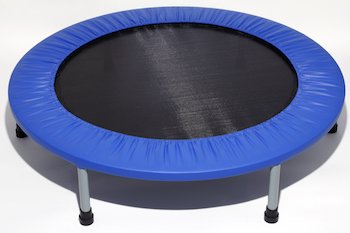 Some people suffer from genetic lymphatic deficiency conditions, while others are prone to lymphedema because of lymph node removal; up to 50% of those who get Auxiliary Lymph Node Dissection may develop lymphedema, according to National Cancer Institute statistics [2].
Some people suffer from genetic lymphatic deficiency conditions, while others are prone to lymphedema because of lymph node removal; up to 50% of those who get Auxiliary Lymph Node Dissection may develop lymphedema, according to National Cancer Institute statistics [2].
The vast majority of lymphatic conditions, however, could be prevented by simply moving the body more and making other lifestyle changes. Especially for those who have had several lymph nodes removed, regular exercise can significantly reduce symptoms.
The most renowned study showing the health benefits of rebounding was a 1980 investigation conducted by NASA and the University of Kentucky [3]. The purpose was to determine the best kinds of exercise for astronauts, who inevitably lose muscle mass while in space.
In the study, healthy male athletes ages 19-26 were instructed to run on a treadmill with intervals of rest in between. Pulse, oxygen consumption, and other factors were measured. A week later, the athletes returned to be tested using the same parameters on a trampoline.
Here are some of the discoveries researchers made:
The “magnitude of the bio-mechanical stimuli” is higher using a mini-trampoline than a treadmill. This finding led researchers to postulate that rebounding may help in determining “remedial procedures” for returning astronauts.
“The external work output at equivalent levels of oxygen uptake were significantly greater while trampolining than running” and that the “greatest difference was about 68%.” This is significant because it indicates that using a trampoline as opposed to a treadmill can give a person a solid aerobic workout and corresponding healing effects with less effort (i.e. oxygen used and demand on the heart).
Additionally, NASA researchers noted that the “biomechanical conditioning” (benefits of the workout on the body) may be twice as efficient with trampolining than running.
The study recognized how extremely low-impact rebounding is. Putting less pressure on the muscles and joints, especially the ankles, knees, and hips, allows a person to exercise at longer intervals without feeling fatigued.
A study published in 2014 found that 12 weeks of exercise with a mini-trampoline “significantly” helped elderly women with their balance [4].
Others speculate that a mini-trampoline may be particularly beneficial for those who have knee and other joint issues, including arthritis. The smaller diameter prevents how high you can jump, and also reduces the gravitational pull on your knees, reducing impact [5].
“Rebounding allows the muscles to go through the full range of motion at equal force. It helps people learn to shift their weight properly and to be aware of body positions and balance,” said Dr. James White, PhD, director of research at the physical education department at the University of California at San Diego, in an interview with Vitality Magazine [6].
In that same article, Vitality Magazine explains how rebounding can significantly help with symptoms of lymphedema through “muscle contraction, force of gravity, and internal massage,” all of which can encourage lymphatic flow.
Can Rebounding Even Help to Prevent Cancer?
Getting your lymphatic system going again through rebounding doesn’t only prevent painful symptoms in the extremities. Rebounding, along with proper hydration and a healthy lifestyle, helps to lower the risk of disease in general with its lymph-boosting, inflammation lowering, blood-cleansing, and detoxification-aiding attributes.
Besides harboring T and B lymphocytes, the lymph nodes are also a production place for Natural Killer cells [7], which specifically target cancer cells for destruction.
3 Types of Rebounder Workouts
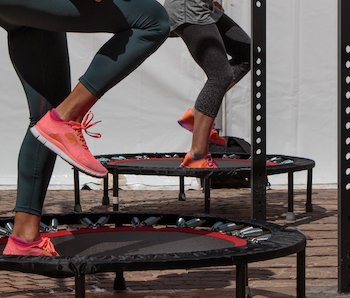 Natural healing advocate Chris Wark of Chris Beats Cancer personally used rebounding as one of his main protocols for naturally healing from colon cancer [8]. He explains three main modes of rebounder trampoline exercise:
Natural healing advocate Chris Wark of Chris Beats Cancer personally used rebounding as one of his main protocols for naturally healing from colon cancer [8]. He explains three main modes of rebounder trampoline exercise:
#1: The Health Bounce:
Lightly bounce up and down on the rebounder while leaving your feet on the mat. This is designed for those who may not be able to do more aerobic tramping, and can be done several times a day from 10 minutes up to an hour.
#2: The Strength Bounce:
This bound has one step: simply bounce as high as you safely can! It is built for strengthening muscles, improving balance, and moving lymphatic fluid.
#3: Aerobic Bounce:
You can dance, jump, twist, run, or invent your own move. Just keep up the intensity until you get your blood pumping and start to sweat.
Where Can You Rebound?
You can rebound at the gym, but most individuals purchase a mini-trampoline to use at home and/or a collapsible travel rebounder to take on the road.
Mini-trampolines are fairly inexpensive, but spending a bit more to get a premium rebounder trampoline may be worthwhile. Just be sure that your mini-tramp has enough spring to prevent jarring of the knees and other joints.
The popularity of rebounding signifies a greater understanding of the importance of the lymphatic system for overall health, boosting the immune system, lowering inflammation, and creating detoxification, energy, and vitality in the body.
It is safe to say that rebounding could rank among the top exercises for overall disease prevention. It’s official: trampolines are not just for kids anymore!
Turmeric 3D from Organixx provides you one of the most “bioavailable” forms of turmeric due to its unique fermentation process. This means your body experiences the maximum benefits of the purest, most potent turmeric available!
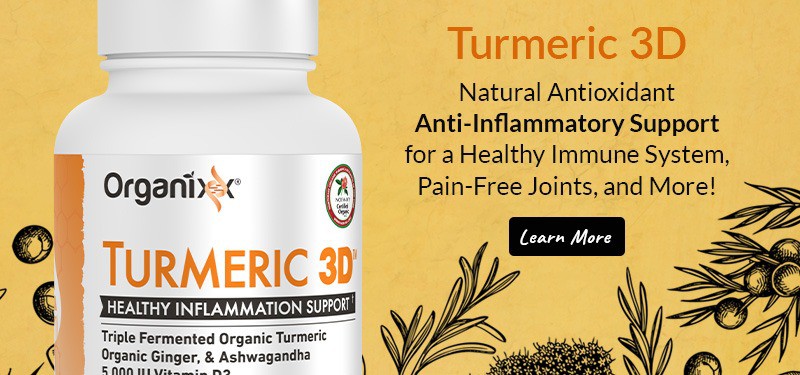
Seventy percent of fulltime American workers spend the majority of their day sitting in a chair. In fact, studies have found that Americans in general spend about 13 hours a day on their rear ends. New research is discovering just how bad this is − and why we need to move more.
Why Movement is Vital for Your Health
 Maybe you heard the phrase: Sitting is the new smoking.
Maybe you heard the phrase: Sitting is the new smoking.
This sounds like a pretty harsh statement; perhaps even a little alarmist. After all, how can being stationary be worse that inhaling known carcinogens? But recent research into the subject is saying just that.
The recently popular saying was coined by Dr. James Levine, famed endocrinologist and world expert on obesity, principle investigator at the US National Institutes of Health (NIH), and director of the Mayo Clinic-Arizona State University Obesity Solutions Initiative.
Levine himself puts the seriousness of stagnation in perspective:
“Sitting is more dangerous than smoking, kills more people than HIV and is more treacherous than parachuting. We are sitting ourselves to death.”
In particular, studies by Levine and others have shown that lack of movement is not only connected to obesity, but can also impair aerobic capacity, cognitive function, muscular-skeletal metabolism, and genetic stability. It can lead to depression, hip and back fracture, and certain kinds of cancer − including colon and breast.
It’s About Making the Commitment to Move More
All that being said, the solution to lack of movement is fairly easy. You guessed it − more movement!
If you don’t have use of a standing desk or desk treadmill (see below), or even if you do, most of the suggestions mentioned below rest on the commitment YOU need to make to give your butt a break at least every hour (every half hour is ideal).
We’ve all been there: when we are under a time crunch or are deeply involved in what we are doing, it is easy to forget. A simple way to get yourself to STAND UP AND MOVE AROUND at regular intervals is to set an alarm on your phone, on an alarm clock or through an online site as a reminder.
This strategy has a positive psychological effect as well. For under-the-gun workers putting in long hours on big projects, breaking up the time one works on the project into smaller chunks (and smaller time chunks as well) can help prevent overwhelm, according to the University of Georgia and others.
10 Easy Ways to Move at Home or at the Office
Here are 10 ways that office workers can sit less and move more during the day. And even if you don’t work at a desk job, tips 4 through 10 are great for anyone to do day or evening to get up off the coach or away from a device for a few minutes.
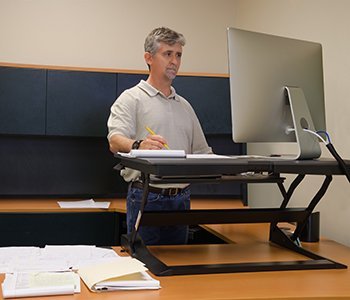
#1 – Use a standing desk.
Standing desks are becoming very popular in the office setting, for home use, and also on the go with smaller portable units that can fit on top of a regular table or desk. Make sure you wear comfortable shoes while you stand and you may also want to invest in an anti-fatigue mat for prolonged standing.
Note: If you use a standing desk, experts still advise that you take breaks to move around, stretch and get blood flow going periodically. If you work at a computer, this will give your eyes a break from the screen too.
#2 – Use a “balance ball chair.”
Another option if you must to sit is to use a “balance ball chair” which will allow your body to stretch through micromovements while you work. The ball and the stand usually come as separate units and the whole thing can be easily purchased for under $200.
What’s more, with most units, the ball simply rests on the chair stand so when you want to do a full ball workout, all you have to do is take the ball out of the stand and you are ready to roll.
#3 – Get an office tread mill.
This modality is the ultimate for those who want a work-workout combo. If you have the money to spend (they go for about $2,000 up to several thousand), a treadmill desk will keep you in motion while you type, talk, or search.
For the more budget-conscious, options also exist for stand-up as well as low-sitting bicycles specifically designed to be used at a desk. Check online for available options.
#4 – Use a portable rebounder.
Another option for room or office-ready mini-workouts is to get yourself a small, portable trampoline, also called a rebounder. Research on immune and lymph system health indicates that rebounding is one of the best forms of exercise for these systems. What’s more, modern day rebounders are small and many come with a carrying case they can be folded into when you travel (or if you want to take it to work with you).
You can use the rebounder while you stand and slightly bounce while you work and you can also use it for more directed movement during a quick break; just a few minutes of rebounding can do wonders for your cardio and lymph systems.
Rebounders range in price from under $100 for stationary units to around $500 for top-of-the-line foldable trampolines.
#5 – Use the dog as an excuse.
Do you work at home and own a dog? That’s great news! Instead of trying to get him or her to stop staring at you while you work, why not use your pup as an excuse for a quick jaunt outside for some playtime? Throw the ball or frisbee for a few minutes or grab the leash and take him for a bathroom break. Your dog will love you and you’ll love the fresh air (if you own a cat, you’re on your own).
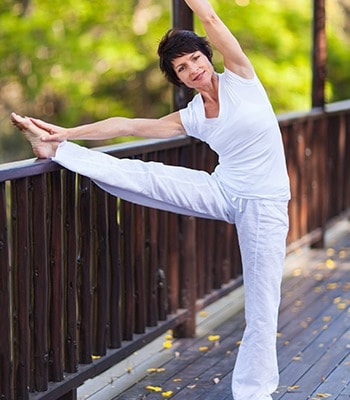
#6 – Do some standing stretches.
If you are REALLY on deadline or just can’t afford 5 minutes to get moving, here is a quick and effective stretch that will give you instant energy and stop your back and typing muscles from atrophying: The Donna Eden “Egyptian Stretch.”
As Donna says herself, this is probably the most ancient stretch there is. Simply extend one arm up as high as it will go. Reach for the ceiling or the sky with that arm while the other arm reaches for the floor. Lift your toes and stretch your entire body while you breathe in deep. Exhale to release and change sides.
Other stretches you can do include bending at the waist and letting your hands dangle to the floor then swaying from side to side for 10-15 seconds (be sure to come up slowly) as well as… bouncing! Simply vibrate your entire body while standing and breathing deep for one to two minutes. You will be surprised at how energized this simple exercise can make you feel.
#7 – Take a short walk.
Get out of your chair, change into your athletic shoes, put on a jacket if you need to, set your timer and get outside! A brisk 5-10 minute walk around the block or the parking lot can do wonders for your mental and physical state.
If you are able to use your phone on speaker mode, why not take that important phone call while walking? Setting up “walking meetings” with colleagues and clients is also a great way to get business done and keep your body moving.
#8 – Practice Deep Breathing.
Stand up and breathe deeply in and out 5-6 times, inhaling for 4 seconds, holding for 4 seconds and exhaling for 4 seconds each time. For a more intense experience, while standing or sitting, practice the “breath of fire.”
Extend your arms in the air, make fists with your hands while keeping your thumbs extended and breathe fast for 30 seconds to a minute, pumping your stomach while you do this. Then slowly release your arms to your sides. This is an ancient yogic modality that is designed to help the nervous system and give instant energy.
If you are still feeling stressed or lethargic, consider a few more minutes of gentle breathing while doing Emotional Freedom Technique (EFT), which is designed to lower stress directly within minutes.
#9 – Clean Something.
If you work at home, save making your bed for your first break of the day. Vacuum, dust, do some laundry, or weed the walkway. If you are at your office, take out the trash, stand up and dust a shelf, sweep or vacuum if you can. All of these actions are ways to move your body without calling it a “workout.” Set a timer for 5 or 10 minutes or choose to just do one chore for each stretch break you have during the day.
#10 – Dance!
Okay, you may not be able to do this if you work amongst a large number of people, but if you have an office where you can shut the door or you work at home, this option for movement during the day can be very effective, and also a whole lot of fun.
When your timer goes off for your break, choose an upbeat, positively-focused song (makes sure it’s one of your favorites!) and commit to getting down for the duration of the song.
Most popular songs are between 2 minutes and 5 minutes long, creating the perfect little time bubble to get your groove on and your body moving. What’s more, it will probably put a smile on your face as well!
More Helpful Hints for a Healthy Workday
 Periodic or continual movement while you work will do wonders for your productivity and mental state, not to mention your physical health.
Periodic or continual movement while you work will do wonders for your productivity and mental state, not to mention your physical health.
In addition, follow these other guidelines to stay alert, sharp and balanced during your work day:
- Use EMF protection in your workspace to protect from electro-pollution from computers, cell phones and wireless routers.
- Drink plenty of water throughout the day and eat a light, vegetable-focused lunch. Heavy eating, especially too many carbs, can cause extra lethargy and “brain fog” as your body struggles to digest all that food. Drinking plenty of fresh, filtered water helps your body to detox and keeps you more energized.
- Use essential oils to energize in lieu of that extra cup of coffee. A few drops of peppermint oil on the temples or breathed in from the palms can have an instantly energizing effect.
- Go outside at least once or twice during the day. Unfortunately, studies show that indoor pollution is often much worse than outdoor pollution − so much so that some researchers have coined the term “sick building syndrome” for the symptoms related to consistently being exposed to indoor contaminants.
Want to Be Healthier? Sit Less & Get Moving!
Inactivity can be dangerous for your health, and not just according to Dr. Levine. Physical inactivity is the fourth-leading risk factor for death and leads to an estimated 3.2 million deaths worldwide, each year according to the World Health Organization.
If you think about it, this makes perfect common sense. There was a time − before the era of obesity, chronic disease and exponential cancer rates − when the average individual spent most of his or her day in movement, either working on a farm, doing household chores, or walking, stooping, and running in order to gather the necessities of life.
Of course, most of us are living in very different times, but that doesn’t mean that our bodies don’t need the same amount of physical activity that they did back then. They do! What our new reality (and your healthy body) needs now is just a little bit of added creativity in order to move more — and thrive! − in the modern world in which we live.
Better Focus… Crystal-Clear Thinking… a Razor-Sharp Memory… ALL Are Within Your REACH! Each and every bottle of our Organixx Brain Health 8 formula contains a total of 8 superstar ingredients, straight from the AMAZON rainforest.




